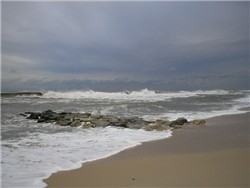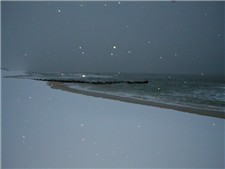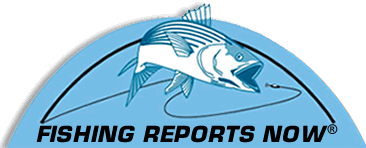page 2 of 2 |
|
| Surf's Up | |
Continued from previous page ... |
|
 The surf at Lavallette. A series of small jetties attracts fish and bait along this town and neigboring Ortley Beach. |
THE FISHING Down to the nitty gritty: Rods Most know that surf anglers have two types of rods in the arsenal, a bait rod and a plugging rod. Paul recommends a 10-foot rod for bait fishing, but anglers can go up to 11 or 12 feet, depending on seas. He suggests a moderate fast rod with medium to heavy action and a reel to match, no matter whether spinning reel or conventional. |
Many companies, including Tica and Daiwa, put out phenomenal rods for bait fishing. A Lamiglas can also be used, but their moderate-fast rod is whippy, and some anglers hesitate to use it, because they’re afraid it will break, Paul said. For a plugging rod, he prefers an 8- to 10-foot, light to medium rod with a moderate fast action, and namely he favors the Lamiglas XS101MH, a 10-footer for popping plugs. Grumpy’s can help anglers choose a matching rod and reel for different types of fishing and different budgets. They also specialize in building custom rods. Bait The bait should match the hatch. When mullet are running, dunk mullet. However, mullet is always a favorite bluefish bait in the fall, no matter whether mullet are migrating, Paul said. Bunker is the second favorite for blues, and bunker is also good for both blues and bass. Of course, when bunker is in the water, again, match the hatch. If anglers are only targeting stripers, they can throw clams. When fishing clams, the rougher the surf the better, because the pounding waves break up the clams, and stripers key in on the food. When the fall migration of stripers is on, Paul recommends fishing either bunker or clams for the fish. Paul prefers a single-hooked fish-finder rig for stripers. For clams, he likes a 12/0 Mustad circle hook. |
|
When bunker chunking, he favors a 9/0 or 10/0 Mustad or Gamakatsu. Many of his customers buy double-hooked high-low rigs. For bluefish, a mullet rig works well, and Paul receommends a wire leader to prevent bite-offs from the toothy critters. He’s even seen them bite a 40-pound wire leader in half. |
 The surf fishing season seems to be getting later and later in the year. Snow falls at Ortley Beach in December 2006, and the fishing would remain consistent through mid January. |
You want the bait to move a little, Paul said, and many anglers think that the bait is supposed to hold still on the bottom. But no bait naturally sits still in the surf, so neither should yours. Paul fishes Hatteras sinkers, because they’re more aerodynamic, and they also seem to hold the bottom better when necessary. He usually fishes one place up to 1 ½ hours, and if nothing bites, he moves on. These fish are migrating, on the move, and you’ve got to find them. Don’t stay in one spot. If you move around, you’ll find the bites. Plugs Swimming plugs work well in the fall, but lots of lures will draw attention. These include pencil poppers, Polaris poppers, needlefish, Ava jigs and Krocodile jigs. Again, match the hatch. If mullet are schooling, use a larger lure like a popper. If sand eels are there, cast a needlefish or jig. Medium-sized lures work at first during the season, but by November and December, smaller lures are key, because the water is colder, and the fish are more lethargic, not looking for a big meal. Paul like many anglers fan casts the plugs, covering the area and then stepping along to the next spot. Methods A quick note about fishing methods. Much can be said about how to fish the bait and plugs, and that can be the subject of many articles itself. For example, I heard a surf sharpie give a clinic and tell the audience that if a striper hits a lure, be sure to keep working the lure however you were working it before, because stripers will come back repeatedly to attack. It’s a large subject and mostly beyond the scope of this article. Location Grumpy’s is located in the most popular surf-fishing town in the state, Seaside Park, one of the most famous surf locations in the country, for those in the know. Eighty percent of Grumpy’s customers fish nearby Island Beach State Park, the beautiful natural area with lots of fishing options. It’s a peninsula jutting into the water and surrounded by the ocean, Barnegat Inlet and Barnegat Bay. The inlet and bay are themselves world-famous for fishing. The surf in the park offers plenty of fish-holding structure, rips, holes and so on. Beach buggies can drive along its coast, one of the main attractions. The pocket at the Barnegat Inlet jetty in the park is one of the most popular fishing holes, an area especially alive with bait and fish. The pocket is usually the first place to give up action during the season, as it was this year. The stretch of beach from Lavallette to Ortley Beach is the second most popular area. A series of small jetties there attracts the fish, and this part of the coast is also usually one of the first to produce fish locally. It offers easy access at the end of many roads, and beach buggies can also drive part of the area. Customers also fish other spots, including Mantoloking and Bay Head. But these places are walk-on only. They receive lots of foot traffic and are surrounded by pretty exclusive residences, and the residents aren’t always so keen on all the visitors. So Paul usually steers customers to other areas. Anywhere from Manasquan Inlet to Sea Girt and Elberon is also productive. THE POINT |
|


